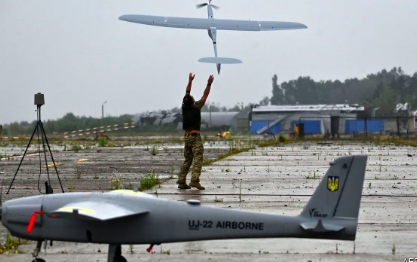Photo Courtesy of The Economist
Large numbers of the weapons used now in the Russo-Ukrainian war would likely be familiar to a lieutenant seventy-five years ago. Artillery-pieces mulch men and fields, whilst rocket launchers (known in WWII as Stalin-organs, for their vague resemblance to the instrument) bombard trenches. Tanks lumber across the lines, and the clatter of rifle fire can be heard over fields.
Rather less visible are the new class of military technologies that whir softly across the battlefront, transmitting reams of data to commanders and even dropping grenades into enemy trenches. These are unmanned vehicles, built in garages and warehouses by iconoclastic boffins around the world, and now as ubiquitous as any traditional battlefield instrument. They are controlled by tablets, and the reams of data beamed back to H.Q. are funneled into apps, resembling consumer services such as Uber, that work in concert with the typical tanks or artillery-pieces. According to Ukrainian and NATO commanders, drones are fast assuming a position of primacy in the stable of lethal technologies with which the world’s armies are equipped.
Since the War on Terror, the public image of a drone has been that of a fixed-wing, propeller-driven unit closely resembling a traditional military aircraft. In truth, though, drones exist across domains — sea, land and air — and assume forms as diverse as those of traditional armaments. Military hardware ranges from cheap handheld quadcopter drones to large aircraft and even naval vessels. All have the potential to work with one another. October 2022, blurry footage surfaced of a fleet of ‘uncrewed surface vessels’ (drone boats, to you or I), swarming the Admiral Makarov, the flagship of Russia’s Black Sea Fleet. The boats, which cost just a quarter of a million dollars each, were supported by unmanned air cover. According to H.I. Sutton, an author and naval analyst, the USVs were powered by cheap Jet-Ski motors and were operated via the Starlink satellite internet service. Six weeks later, an oil storage terminal in Novorossiysk was also targeted by the naval drones. Ukraine’s crowdfunding platform, UNITED24, hopes to raise enough cash to build 100 attack vessels. The assault presented a model of warfare in which remotely operated vehicles are placed at the heart of military operations.
Increasingly, militaries are restructuring themselves around this new vision of war. Shortly after the USV attack on the Makarov, General Dynamics, a US defense contractor, released a prototype of AbramsX, a hybrid-electric battle tank equipped with four Switchblade 300 ‘kamikaze drones’ and a remotely-controlled gun turret. Fearing that current military technologies will be made obsolete by the rise of automation and remote operation, the US government is also investing millions of dollars into retrofitting legacy technologies with autonomy and remote-operation capability. Shield AI, a startup, has developed a software kit called Hivemind which it bills as a ‘top gun for every aircraft.’ The company claims a 99% win percentage in simulated dogfights with Navy pilots, and says that its co-pilot firmware will make the F-16 fighter jet, which was introduced in 1978, ‘relevant for decades to come.’ Shield AI was last valued at $2.3 billion in the summer of 2022.
It must be noted, however, that only a small proportion of drones operated by Russian or Ukrainian forces occupy a place at the leading edge of military technologies. Reports suggest that the DJI (Da-Jiang Innovations, a Chinese manufacturer) Mavic 3, an off-the-shelf consumer-level drone, is a favorite choice of both the Russian and Ukrainian militaries. A Mavic can be bought at any Best Buy for the price of a laptop. Low cost and volume has been emphasized by Ukrainian officials alongside such innovations as naval drones and snazzy tanks. In fact, military strategists in the United States, China and EU have advocated a ‘swarm’ approach, in which hundreds or thousands of cheap drones overwhelm enemy air defenses.
The drone line-ups advertised on government websites, however, reveal much about the drone armies of tomorrow. They will resemble the human ones of 1945: legions of cheap and disposable units backed up by smaller numbers of large top-grade ones, spreading far the same death and despair. Unmanned technology might have repacked war in aerodynamic casings and touchscreens, but in the trenches of Ukraine, the outcome is much the same as it might have been eight decades ago: fields pockmarked by craters, trenches stuffed with bloodied men, and thousands of dead of Ukraine to mourn.






